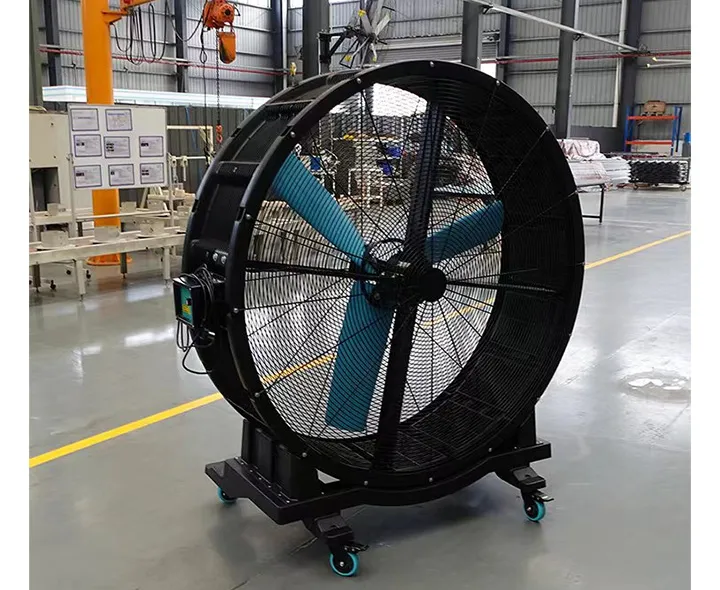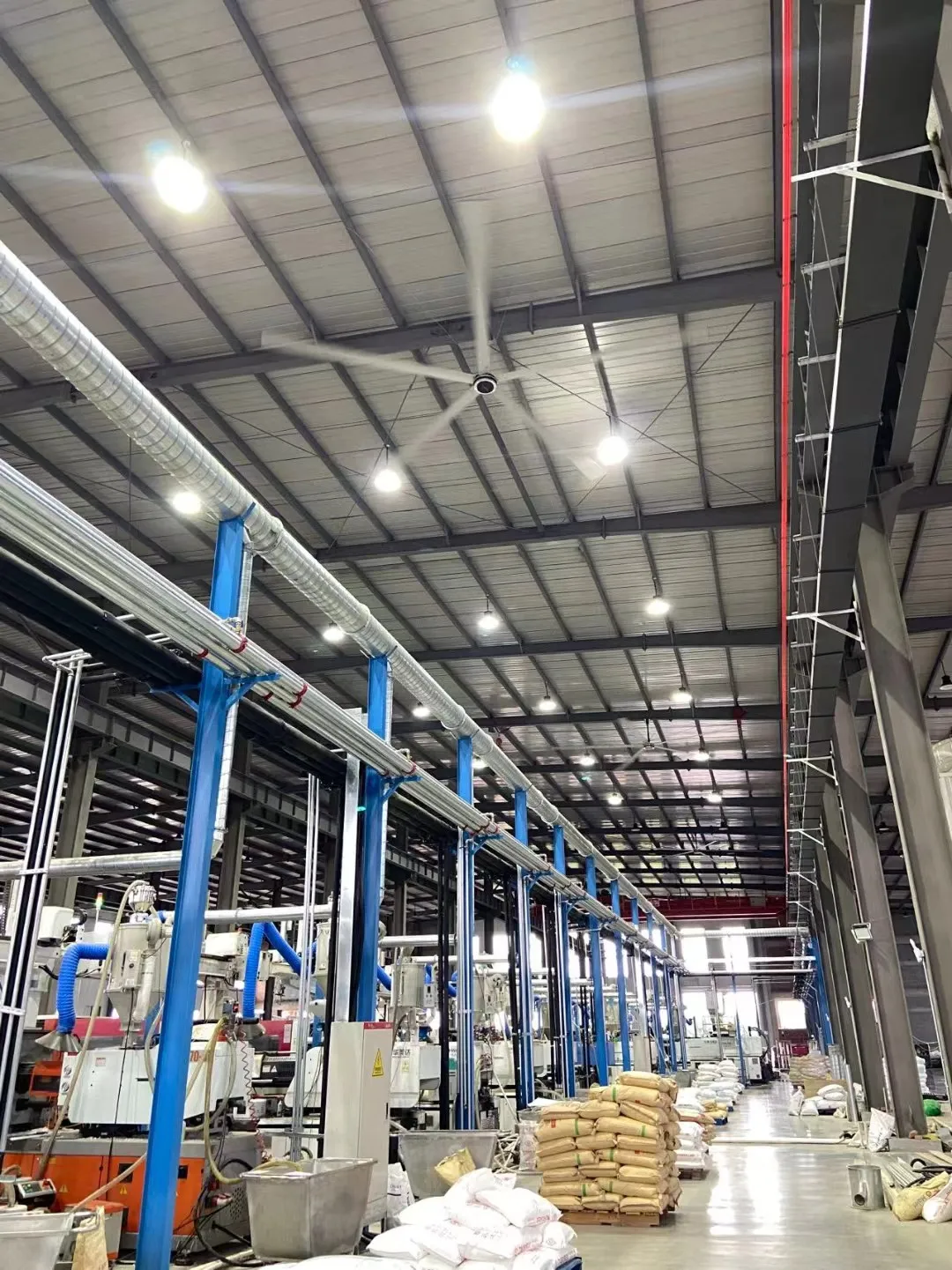Hot, stagnant air kills productivity. Workers sweat, equipment overheats, and energy bills climb. The fix isn’t “more small fans”—it’s choosing the right industrial solution and installing it correctly.
An industrial shop fan moves high CFM air in a focused zone, while an HVLS ceiling fan circulates big air slowly across large spaces. Pick shop fans for targeted cooling or spot drying; choose HVLS for effective air circulation, energy efficiency, and comfort in warehouses, gyms, and commercial spaces.
%industrial shop fan hvls ceiling fan airflow
Um industrial shop fan is a portable or fixed, heavy-duty air mover designed for concentrated fluxo de ar in a defined workspace ou workshop. It blasts high CFM air at alta velocidade to cool people, dry floors, or clear fumes. An Ventilador de teto HVLS (high-volume, low-speed) spans up to 24 feet and rotates slowly to circular ar across massive areas like a armazém, fábrica, or gym with baixo ruído and minimal consumo de energia. Both are industrial, but the use case, instalação, and effects on níveis de ruído differ.

industrial shop fan
We manufacture both. As an HVLS fans manufacturing plant, we’ve watched facilities waste power on small oscillating units that never touch the hot spots. Once they switch to industrial HVLS systems, they improve air quality, comfort, and produtividade—and yes, they spend less on AC .
**Key differences in one glance: **
| Recurso | Industrial Shop Fan | Ventilador de teto HVLS |
|---|---|---|
| Primary Goal | Targeted spot cooling | Room-wide effective air circulation |
| Typical Size | 24 inch to 36 inch | 8 ft to 24 ft diameter |
| Montagem | Floor / wall / drum / pedestal | Ceiling (structural) |
| Air Movement Style | Directional blast (can oscilar) | Gentle, even air movement |
| Níveis de ruído | Mais alto | **Quiet operation ** |
| Eficiência Energética | Médio | Very eficiente em termos energéticos (high-volume, baixa velocidade) |
| Controlar | Often simple 3 speed or variable | Networked, BMS-ready, fan with remote control |
CFM (cubic feet per minute) tells you how much air a fan moves. A 24 inch industrial floor fan can hit 7,000–10,000 CFM, but a 20-ft HVLS can exceed 300,000 CFM. When you compare, match CFM to espaço volume and heat load. Powerful airflow is not about wind chill alone—it’s about mixing stratified air to melhorar o ar temperature uniformity.
Our fans are pre-wired to speed commissioning. Fãs projetados for harsh environments deliver consistent CFM even with dust or humidity.
Fontes: ASHRAE 55 Thermal Comfort Standard, OSHA Ventilation Guidelines .
Diferentes tipos de ventiladores solve different problems:
Meanwhile, an HVLS unit covers the entire interior area with one device. Consider características do ventilador de teto like variable frequency drives, smart sensors, and integration with lighting or HVAC controls.
We help you map instalação points, structural loads, and electrical runs so you can order industrial systems with confidence.

Oscillating wall mount fan
Apropriado instalação is safety and performance. For HVLS:
For smaller gear like a fan with remote control ou um 3 speed unit:
Fontes: UL Standards, NFPA 13 Sprinkler Clearance .
Energy is money. An HVLS fan’s eficiência energética comes from moving alto volume air at baixa velocidade. That’s why industrial hvls systems often pay for themselves by cutting consumo de energia on HVAC.
Fontes: U.S. DOE Fan System Efficiency, OSHA Noise .
Controls save labor and time. A wall switch is fine, but plants love central dashboards or mobile apps.
Ask yourself: will operators actually use advanced modes? If not, keep it simple—and os fãs fornecem value without complexity.
Ar livre loading bays collect diesel fumes. One oscillation-capable unit on each side can flush them fast. In a academia, comfort equals membership retention; an HVLS over the cardio zone keeps sweat off the floor. In a armazém, we used four HVLS fans to cut AC run-time by 30% and boost produtividade .
In a metal workshop, sparks fly—so we spec spark-resistant motors and guards. In a food fábrica, washdown-rated housings meet hygiene rules. Different sectors, one goal: effective air circulation.

Ventilador HVLS em uma fábrica
Regulators care about safe wiring and guarding. Our products are grau industrial e UL verified. We follow OSHA for spacing, guarding, and lockout/tagout.
Fãs projetados para fans and industrial environments need proper labels, manuals, and training.
HVLS significa alto volume, baixa velocidade. Massive blades move slowly to circular ar gently but broadly. This “big air” effect destratifies heat layers, cuts condensation, and reduces HVAC loads.
We position HVLS as the backbone; then ventilador de tambor, ventilador de pedestal, or an oscillating wall mount fan handles corners or temporary tasks. Together, fans deliver a balanced climate.
Quando você order industrial HVLS, ask for actual CFM curves, not just marketing numbers.
Before you sign:
**How do I size a fan for my warehouse? **
Calculate volume (L×W×H) and divide by desired air changes. Then match that CFM with either one HVLS or multiple smaller units.
**Can HVLS work with AC systems? **
Yes. HVLS lowers the perceived temperature and evens out thermal layers, so HVAC runs less. That’s direct eficiência energética .
**Are these fans safe around sprinklers and lights? **
Absolutely—if installed to code. Maintain NFPA clearances, use UL safety listed gear, and verify instalação especificações.
**What if my ceilings are low? **
Use smaller diameter HVLS or a motor ceiling fan. Otherwise, combine a ventilador de pedestal com um ventoinha oscilante to cover long aisles.
**Do I need variable speed or is 3 speed enough? **
If your heat load changes often, variable is worth it. Otherwise, 3 speed may be fine.
**Can I put these outside? **
Yes, but select ar livre-rated coatings and IP-rated motors. Salt air? Ask for marine protection.

Olá, eu sou Michael Danielsson, CEO da Vindus Fans, com mais de 15 anos de experiência na indústria de engenharia e design. Estou aqui para compartilhar o que aprendi. Se você tiver alguma dúvida, sinta-se à vontade para entrar em contato comigo a qualquer momento. Vamos crescer juntos!